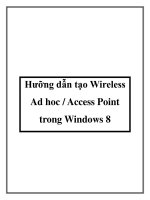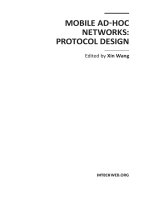Mobil Ad Hoc Networks Protocol Design Part 8 pot
Bạn đang xem bản rút gọn của tài liệu. Xem và tải ngay bản đầy đủ của tài liệu tại đây (873.81 KB, 40 trang )
12 Theor y and Applications of Ad Hoc Networks
Location Networks QDV Target
A Mobile Wi M AX
1
0.793 Mobile Wi M AX
1
UMTS 0.219
MobileWi M AX
2
0.569
B WLAN
1
0.517 Mobile Wi M AX
2
UMTS 0.339
Mobile Wi M AX
2
0.561
C WLAN
1
0.748 WLAN
1
UMTS 0.275
Mobile Wi M AX
2
0.436
D WLAN
2
0.459 WLAN
2
UMTS 0.282
Mobile Wi M AX
2
0.391
E WLAN
3
0.674 WLAN
3
UMTS 0.317
Table 3. QDVs of Candidate Networks
x − ˆw
n
=
min
i=1, ,6
x − ˆw
i
(23)
where the index n denotes the wining neuron number and w
n
=
[
w
n1
w
n2
, , w
n30
]
is the
weight vector to the n
th
neuron. Weight adjustment in the k
th
step of the winner uses the
learning rule as (Zurada, 1992)
w
k+1
n
= w
k
n
+ α
k
(x −w
k
n
) (24)
w
k+1
i
= w
k
i
for i = n (25)
where α
k
is a learning constant at the k
th
step.
In the simulation, an area in which there are three WLANs, two WiMAX and a UMTS
is considered as shown in Fig. 6. We first evaluate the performance under number of
users ranging from 100-2100, as seen in Figs. 8-10. Figure 8 illustrates that the proposed
PRSS+FQDA approach yields the fewest number of vertical handoffs in comparison to
the PRSS+HT and SOM approaches. Meanwhile, the numbers of vertical handoffs of all
approaches increase when the number of users increases. The number of vertical handoffs
using PRSS+FQDA is gently increases as the number of users increases, but that of PRSS+HT
and SOM obviously increase. In Fig. 9, the dropping probability of PRSS+FQDA is fewest
since it determines theoptimal network regarding to the networkcondition whether it satisfies
the preference of users and has a strong RSS as well. Accordingly, this yield the fewest GoS
using the PRSS+FQDA approach as shown in Fig. 10.
The performance metrics under different arrival rates ranging from 6 to 16 are demonstrated
in Figs. 11-13. The simulation results shown in Figs. 11-13 reveal that the proposed
PRSS+FQDA approach outperforms the PRSS+HT and SOM approaches in terms of the
number of vertical handoffs, handoff call dropping probability and GoS. In Fig. 11, the
number of handoffs increases gradually as the mean arrival rate increases while PRSS+HT and
SOM quite increase. Figure 12 shows the dropping probability comparison. The PRSS+FQDA
272
Mobile Ad-Hoc Networks: Protocol Design
Predictive RSS with Fuzzy Logic based Vertical
Handoff Decision Scheme for Seamless Ubiquitous Access
13
.
.
.
.
.
.
.
.
.
1
x
2
x
3
x
P
x
nP
w
n
y
1
y
1n
w
2n
w
N
y
3n
w
Fig. 7. SOM neural network
scheme yields the lower probability than other schemes which results in a fewest GoS as
shown in Fig. 13.
In Figs. 14-16, we presented the results of the proposed PRSS+FQDA approach for the
handoff numbers, handoff call dropping probability and GoS under various mobile velocities
ranging from 5 to 30 m/s comparing to the other three vertical handoff algorithms, namely the
PRSS+HT and SOM approaches. In Fig. 14, PRSS+FQDA yields the fewest vertical handoffs
under various velocities but PRSS+HT yields the most vertical handoffs. As the velocity
increases, the numbers of vertical handoffs of all approaches also increase. However, the
impact of velocity to PRSS+FQDA is less than PRSS+HT and SOM. The handoff call dropping
probability of the different approaches are investigated in Fig. 15. PRSS+FQDA has the
lowest dropping probabilities and gently increases as the velocity increases while the other
three methods obviously increase. Finally, the GoS versus mobile velocity of all approaches
are shown in Fig. 16. The proposed PRSS+FQDA approach achieves low GoS although the
mobile is moving in high speed. PRSS+HT and SOM generate higher GoS and proportionally
vary to the velocity.
8. Conclusions
This paper has proposed a predictive RSS and fuzzy logic based network selection for vertical
handoff in heterogeneous wireless networks. The RSS predicted by back propagation neural
network is beneficial to avoid dropping calls if it predictes a mobile is moving away from
the monitored wireless network. In additional to the RSS metric, the residence time in the
target network is predicted which is taken into account for handoff trigger. The prediction
period is calculated by the adaptive dwell time. For nonreal time service, the handoff policy
is to attempt to use services of WLAN/WiMAX as long as possible. Meanwhile, the handoff
273
Predictive RSS with Fuzzy Logic based Vertical
Handoff Decision Scheme for Seamless Ubiquitous Access
16 Theor y and Applications of Ad Hoc Networks
100 300 500 700 900 1100 1300 1500 1700 1900 2100
0
50
100
150
200
250
300
Number of Users
Number of Handoffs
PRSS+FQDA
PRSS+HT
SOM
Fig. 8. Number of handoffs versus numbers of users (Arrival rate = 3 sec)
100 300 500 700 900 1100 1300 1500 1700 1900 2100
0
0.1
0.2
0.3
0.4
0.5
0.6
0.7
0.8
Number of Users
Handoff Call Dropping Probability
PRSS+FQDA
PRSS+HT
SOM
Fig. 9. Handoff call dropping probability versus numbers of users (Arrival rate = 3 sec)
274
Mobile Ad-Hoc Networks: Protocol Design
Predictive RSS with Fuzzy Logic based Vertical
Handoff Decision Scheme for Seamless Ubiquitous Access
17
100 300 500 700 900 1100 1300 1500 1700 1900 2100
0
1
2
3
4
5
6
7
8
Number of Users
Grade of Service (GoS)
PRSS+FQDA
PRSS+HT
SOM
Fig. 10. GoS versus numbers of users (Arrival rate = 3 sec)
6 8 10 12 14 16
160
180
200
220
240
260
280
300
320
340
Mean Arrival Rate (sec)
Number of Handoffs
PRSS+FQDA
PRSS+HT
SOM
Fig. 11. Number of handoffs versus mean arrival rates (Number of users = 1,500)
275
Predictive RSS with Fuzzy Logic based Vertical
Handoff Decision Scheme for Seamless Ubiquitous Access
18 Theor y and Applications of Ad Hoc Networks
6 8 10 12 14 16
0.1
0.2
0.3
0.4
0.5
0.6
0.7
0.8
Mean Arrival Rate (sec)
Handoff Call Dropping Probability
PRSS+FQDA
PRSS+HT
SOM
Fig. 12. Handoff call dropping probability versus mean arrival rates (Number of users =
1,500)
6 8 10 12 14 16
1
2
3
4
5
6
7
8
Mean Arrival Rate (sec)
Grade of Service (GoS)
PRSS+FQDA
PRSS+HT
SOM
Fig. 13. GoS versus mean arrival rates (Number of users = 1,500)
276
Mobile Ad-Hoc Networks: Protocol Design
Predictive RSS with Fuzzy Logic based Vertical
Handoff Decision Scheme for Seamless Ubiquitous Access
19
5 10 15 20 25 30
140
160
180
200
220
240
260
Velocity(m/s)
Number of Handoffs
PRSS+FQDA
PRSS+HT
SOM
Fig. 14. Number of handoffs versus mobile velocity (Number of users = 1,500 and Arrival
rate = 3sec)
5 10 15 20 25 30
0
0.1
0.2
0.3
0.4
0.5
0.6
0.7
0.8
Velocity(m/s)
Handoff Call Dropping Probability
PRSS+FQDA
PRSS+HT
SOM
Fig. 15. Handoff call dropping probability versus mobile velocity (Number of users = 1,500
and Arrival rate = 3sec)
277
Predictive RSS with Fuzzy Logic based Vertical
Handoff Decision Scheme for Seamless Ubiquitous Access
20 Theor y and Applications of Ad Hoc Networks
5 10 15 20 25 30
1
2
3
4
5
6
7
8
Velocity(m/s)
Grade of Service (GoS)
PRSS+FQDA
PRSS+HT
SOM
Fig. 16. GoS versus mobile velocity (Number of users = 1,500 and Arrival rate = 3sec)
278
Mobile Ad-Hoc Networks: Protocol Design
14 Theor y and Applications of Ad Hoc Networks
policy of real time service is to have small delay. Merit function evaluating network conditions
and user preference is used as the handoff criteria to determine candidate networks. Fuzzy
logic using quantitative decision algorithm makes a final decision to select the optimal target
network with the largest QDV. The proposed approach outperforms other approaches in
number of vertical handoffs and call dropping probability and GoS.
9. Acknowledgments
This work is supported in part of by Telecommunications Research Industrial and
Development Institute (Tridi), National Telecommunications Commission Fund under Grant
No. PHD/004/2008.
10. References
Betancur, L., Hincapi
´
e, R. & Bustamante, R. (2006). Wimax channel-phy model in network
simulator 2, Workshop on ns-2: the IP Network Simulator Proceeding, Italy, pp. 1–8.
Bing, H., He, C. & Jiang, L. (2003). Performance analysis of vertical handover in a umts-wlan
integrated network, 14th IEEE International Symposium on Personal, Indoor and Mobile
Radio Communication Proceedings, China, pp. 187–191.
Boudriga, N., Obaidat, M. S. & Zarai, F. (2008). Intelligent network functionalities in wireless
4G networks: Integration scheme and simulation analysis, Computer Communications
Journal Vol. 31: 3752–3759.
Chang, B. & Chen, J. (2008). Cross-layer-based adaptive vertical handoff with predictive rss
in heterogeneous wireless networks, IEEE Transactions on Vehicular Technology Vol.
57: 3679–3692.
Frattasi, S., Fathi, H., Fitzek, F. H. P. & Prasad, R. (2006). Defining 4G technology from the
user’s perspective, IEEE Network Vol. 20(No. 1): 35–41.
Haibo, X., Hui, T. & Ping, Z. (2009). A novel terminal-controlled handover scheme in
heterogeneous wireless networks, Computers and Electrical Engineering Vol. 10: 1–11.
Haykin, S. (2009). Neural networks and learning machines, Prentice Hall Publishing, USA.
Kassar, M., Kervella, B. & Pujolle, G. (2008). An overview of vertical handover decision
strategies in heterogeneous wireless networks, Computer Communications Journal Vol.
31: 2607–2620.
Lee, W., Kim, E., Kim, J., Lee, I. & Lee, C. (2009). Movement-aware vertical handoff of wlan
and mobile wimax for seamless ubiquitous access, IEEE Transactions on Consumer
Electronics Vol. 53: 1268–1275.
Majlesi, A. & Khalaj, B. H. (2002). An adaptive fuzzy logic based handoff algorithm for
interworking between wlans and mobile networks, 13th IEEE International Symposium
on Personal, Indoor and Mobile Radio Communications, Portugal, pp. 2446–2451.
McNair, J. & Fang, Z. (2004). Vertical handoffs in fourth-generation multinetwork
environments, IEEE Wireless Communications Vol. 11(No. 1): 8–15.
Nay, P. & Zhou, C. (2009). Vertical handoff decision algorithm for integrated umts and leo
satellite networks, International Conference on Communications and Mobile Computing,
China, pp. 180–184.
Nkansah-Gyekye, Y. & Agbinya, J. I. (2008). A vertical handoff decision algorithm for
next generation wireless networks, 3rd IEEE International Conference on Broadband
Communications, Information Technology and Biomedical Applications, South Africa,
pp. 358–364.
279
Predictive RSS with Fuzzy Logic based Vertical
Handoff Decision Scheme for Seamless Ubiquitous Access
Predictive RSS with Fuzzy Logic based Vertical
Handoff Decision Scheme for Seamless Ubiquitous Access
15
Pahlavan, K., Krishnamurthy, P., Hatami, A., Ylianttila, M., Makela, J P., Pichna, R.
& Vallstrm, J. (2000). Handoff in hybrid mobile data networks, IEEE Personal
Communications Vol. 7: 34–37.
Pollini, G. P. (1996). Trends in handover design, IEEE Communications Magazine Vol. 34: 82–90.
Sivanandam, S. N., Sumathi, S. & Deepa, S. (2007). Introduction to Fuzzy Logic using MATLAB,
Springer Publishing, USA.
Song, Q. & Jamalipour, A. (2008). A quality of service negotiation-based vertical handoff
decision scheme in heterogeneous wireless systems, European Journal of Operational
Research Vol. 191: 1059–1074.
Stevens-Navarro, E., Lin, Y. & Wong, V. (2008). An MDP-based vertical handoff decision
algorithm for heterogeneous wireless networks, IEEE Transactions on Vehicular
Technology Vol. 57: 1243–1254.
Stoyanova, M. & M
¨
ah
¨
onen, P. (2007). Algorithmic approaches for vertical handoff in
heterogeneous wireless environment, IEEE Wireless Communications and Networking
Conference, Hong Kong, pp. 3780–3785.
Sun, C., Stevens-Navarro, E. & Wong, V. W. S. (2008). A constrained MDP-based vertical
handoff decision algorithm for 4G wireless networks, IEEE International Conference
on Communications, China, pp. 2169 – 2174.
Tansu, F. & Salamah, M. (2006). On the vertical handoff decision for wireless overlay networks,
7th IEEE International Symposium on Computer Networks, France, pp. 111–115.
Xia, L., Ling-ge, J., Chen, H. & Hong-wei, L. (2008). An intelligent vertical handoff algorithm
in heterogeneous wireless networks, International Conference on Neural Networks and
Signal Processing, China, pp. 550–555.
Zurada, J. M. (1992). Introduction to Artificial Neural Systems, Addison-Wesley Publishing, USA.
280
Mobile Ad-Hoc Networks: Protocol Design
15
Energy Issues and Energy aware Routing in
Wireless Ad-hoc Networks
Marco Fotino and Floriano De Rango
University of Calabria
Italy
1. Introduction
The problem of energy efficiency in MANETs can be addressed at different layers. In recent
years, many researchers have focused on the optimization of energy consumption of mobile
nodes, from different points of view. Some of the proposed solutions try to adjust the
transmission power of wireless nodes, other proposals tend to efficiently manage a sleep
state for the nodes (these solutions range from pure MAC-layer solutions (as the power
management of 802.11) to solutions combining MAC and routing functionality). Finally,
there are many proposals which try to define an energy efficient routing protocol, capable of
routing data over the network and of saving the battery power of mobile nodes. Such
proposals are often completely new, while others aim to add energy-aware functionalities to
existing protocols (like AODV, DSR and OLSR).
The aim of energy-aware routing protocols is to reduce energy consumption in transmission
of packets between a source and a destination, to avoid routing of packets through nodes
with low residual energy, to optimize flooding of routing information over the network and
to avoid interference and medium collisions. Many energy efficient routing protocol
proposals were originally studied for sensor networks, where the limited energy of nodes is
a strong constraint; in MANET, however, the requirements are different: a node has
generally more hardware resources (capable of better performance, but consuming more
energy) and the protocol must preserve the resources of every node in the network (not only
a subset of them, because each node can be, at any time, source or destination of data). A
single node failure in sensor networks is usually unimportant if it does not lead to a loss of
sensing and communication coverage; ad-hoc networks, instead, are oriented towards
personal communication and the loss of connectivity to any node is significant.
In the routing protocol design of mobile nodes, many issues need to be considered in order
to offer many important properties such as scalability, QoS support, security, low power
consumption and so on. In this chapter we focus on the energy issues facing some important
aspects going from the energy model definition for the computation of the energy
consumption to energy-aware metrics definition and routing protocol design. If a network
composed of mobile nodes communicatiing using a wireless radio and where each node can
communicate with each other using the other mobile nodes as relay nodes is applied in a
communication system, many challenging design issues need to be addressed. MANET
technology became, in the last years, more commercial in comparison with the past where it
was used for military purpose and this implies more additional features to offer to the end-
Mobile Ad-Hoc Networks: Protocol Design
282
user with particular reference to quality of service, security and to node lifetime duration. In
this chapter energy saving techniques at network layer and the routing strategies that allow
a better energy expenditure and load distribution in order to prolong the network lifetime
are considered. After defining a simple energy consumption model to use as reference for
the protocol performance evaluation and after introducing some well-known energy based
metric, some routing protocols belonging to different families of routing strategies are
briefly presented. In particular we refer to proactive routing protocols with particular
reference to OLSR, reactive routing with reference to AODV, DSR and LEAR, hybrid
routing with reference to GAF, and scalable routing strategies based on the concept of
clustering or topological hierarchy.
2. Wireless ad-hoc networks
MANET is a special type of wireless network in which a collection of mobile network
interfaces may form a temporary network without aid of any established infrastructure or
centralized administration. Ad Hoc wireless network has applications in emergency search-
and-rescue operations, decision making in the battlefield, data acquisition operations in
hostile terrain, etc. It is featured by dynamic topology (insfrastructrureless), multi-hop
communication, limited resources (bandwidth, CPU, battery, etc.) and limited security.
These characteristics put special challenges in routing protocol design. The one of the most
important objectives of MANET routing protocol is to maximize energy efficiency, since
nodes in MANET depend on limited energy resources.
The primary objectives of MANET routing protocols are to maximize network throughput,
to maximize network lifetime, and to maximize delay. The network throughput is usually
measured by packet delivery ratio while the most significant contribution to energy
consumption is measured by routing overhead which is the number or size of routing
control packets. A major challenge that a routing protocol designed for ad hoc wireless
networks faces is resource constraints. Devices used in the ad hoc wireless networks in most
cases require portability and hence they also have size and weight constraints along with the
restrictions on the power source. Increasing the battery power may make the nodes bulky
and less portable. The energy efficiency remains an important design consideration for these
networks. Therefore ad hoc routing protocol must optimally balance these conflicting
aspects.
To achieve the desired behavior, some proposals make use of clustering or maintain
multiple paths to destinations (in order to share the routing load among different nodes).
The majority of energy efficient routing protocols for MANET try to reduce energy
consumption by means of an energy efficient routing metric, used in routing table
computation instead of the minimum-hop metric. This way, a routing protocol can easily
introduce energy efficiency in its packet forwarding. These protocols try either to route data
through the path with maximum energy bottleneck, or to minimize the end-to-end
transmission energy for packets, or a weighted combination of both.
The energy optimization of a routing protocol, however, can exploit also other network
layer mechanisms, like control information forwarding. In OLSR, for example, the MPR
selection mechanism can be varied in an energy-aware way: MPRs can be selected by their
residual energy, rather than by their 2-hop neighborhood coverage. Some works applied
both techniques (MPR selection criteria modification and path determination algorithm
modification) to increase the energy efficiency of OLSR protocol.
Energy Issues and Energy aware Routing in Wireless Ad-hoc Networks
283
3. Issues in MANETs: Energy, scalability and quality of services
Due to the fact that bandwidth is scarce in MANET nodes and that the population in a
MANET is increasing the scalability issue for wireless multi-hop routing protocols is mostly
concerned with excessive routing message overhead caused by the increase of network
population and mobility. Routing table size is also a concern in MANETs because large
routing tables imply large control packet size hence large link overhead. Routing protocols
generally use either distance-vector or link-state routing algorithms and only in the last
years also geographical routing protocols that make use of node location/position have
been investigated (De Rango et al., 2006). However, scalability issues in terms of overhead
and, consequently number of nodes operating in the network, are strongly related also to
energy consumption because higher number of control packets overhead imply more
energy consumption spent in transmission, reception and overhearing. This means that
trying to design a more scalable protocols can offer more benefits also to the energy saving
of mobile nodes in a MANET.
When we consider the design of an energy efficient routing protocols not always this means
that the routing strategies are also scalable because the protocols can reduce the energy
consumption under just some specific operative conditions such as lower mobility, light
traffic load or low number of nodes. This means that the design of an energy-efficient
routing protocols should consider also scalability issue in order to apply it in wider
scenarios and to be sure that the protocol performance do not degrade too much when some
project parameters are changing. At this purpose, more advanced techniques that try to
exploit the clustering formation among nodes, the nodes position, zone location or the
hierarchical topology structure have been considered and some of these techniques are
referred in this chapter. Moreover, another important issue should be considered in the
routing strategies applied to MANETs. It is the QoS in terms of many metrics definition
such as minimum bandwidth availability, maximum end-to-end delay, minimum delay
jitter, path stability and so on. Often, in literature, these QoS issues are not related to energy
consumption but in the protocol design some connection between QoS support and energy
consumption exist. In particular, the selection of the lowest energy path among a couple of
nodes can led to the selection of a longer route with higher end-to-end delay (De Rango,
Guerriero, 2006; De Rango, 2011). Moreover, the possibility to offer higher bandwidth to a
connection and consequently higher data rate imply often to deplete the battery charge of a
node more quickly. In this view, also QoS aware routing protocols should take into account
also the energy issues related to the rationale of the forwarding scheme, route maintenance
and path discovery. In the rest of the chapter, some of the most famous approaches related
to the energy aware routing protocols are presented with particular reference to proactive,
reactive, hybrid, cluster-based, hierarchical and position based routing protocols.
4. Energy consumption model
A wireless network interface can be in one of the following four states: Transmit, Receive,
Idle or Sleep. Each state represents a different level of energy consumption.
• Transmit: node is transmitting a frame with transmission power P
tx
;
• Receive: node is receiving a frame with reception power P
rx
. That energy is consumed
even if the frame is discarded by the node (because it was intended for another
destination, or it was not correctly decoded);
Mobile Ad-Hoc Networks: Protocol Design
284
• Idle (listening): even when no messages are being transmitted over the medium, the
nodes stay idle and keep listening the medium with P
idle
;
• Sleep: when the radio is turned off and the node is not capable of detecting signals. No
communication is possible. The node uses P
sleep
that is largely smaller than any other
power.
Fig. 1. Energy consumption in a wireless network
In Table 1, typical values of consumption for a wireless interface (measured for a Lucent
Silver Wavelan PC Card) are reported.
State
Power value
Transmit P
tx
= 1.3W
Receive P
rx
= 0.9W
Idle P
idle
= 0.74W
Sleep P
sleep
= 0.047W
Table 1. Power value in each radio state
The energy dissipated in transmitting (E
tx
) or receiving (E
rx
) one packet can be calculated as:
tx tx
rx rx
EPDuration
EPDuration
=×
=×
(1)
where
Duration denote the transmission duration of the packet.
When a transmitter transmits a packet to the next hop, because of the shared nature of
wireless medium, all its neighbors receive this packet even it is intended to only one of
them. Moreover, each node situated between transmitter range and interference range
Energy Issues and Energy aware Routing in Wireless Ad-hoc Networks
285
receives this packet but it cannot decode it. These two problems generate loss of energy. So
to compute the energy dissipated by one transmission, we must take into account these
losses as follows (Allard et al., 2006):
cos ( )
tx tx rx
ti E nE
=
+× (2)
where
n represents the number of non-sleeping nodes belonging to the interference zone of
the transmitter
i.
5. Energy aware metrics
The majority of energy efficient routing protocols for MANET try to reduce energy
consumption by means of an energy efficient routing metric, used in routing table
computation instead of the minimum-hop metric. This way, a routing protocol can easily
introduce energy efficiency in its packet forwarding. These protocols try either to route data
through the path with maximum energy bottleneck, or to minimize the end-to-end
transmission energy for packets, or a weighted combination of both.
A first approach for energy-efficient routing is known as MTPR (Minimum Transmission
Power Routing; Toh, 2001). That mechanism uses a simple energy metric, represented by the
total energy consumed to forward the information along the route. This way, MTPR reduces
the overall transmission power consumed per packet, but it does not directly affect the
lifetime of each node (because it does not take into account the available energy of network
nodes). However, minimizing transmission energy only differs from shortest-hop routing if
nodes can adjust transmission power levels, so that multiple short hops are more
advantageous, from an energy point of view, than a single long hop (Kunz, 2008). In 802.11
we do not have access to this capability, so that, in a fixed transmission power context, this
metric corresponds to a Shortest Path routing.
Another routing metric, minimizing a function of the remaining battery power of the nodes
in a path, is called MBCR (Minimum Battery Cost Routing; Toh, 2001). The proposed battery
cost function is
() 1/ ()
ii
f
tct
=
(3)
where
c
i
(t) is the battery capacity of node n
i
at time t. The less capacity a node has, the more
reluctant it is to forward packets.
If only the summation of battery costs on a route is considered, a route containing nodes
with little remaining battery capacity may still be selected. MMBCR (Minimum Maximum
Battery Cost Routing; Toh, 2001), defines the route cost as
() max ()
ij
jnri
Rr f t
∀∈
=
(4)
The desired route
r
O
is obtained so that
()max ()
j
Orr
j
Rr Rr
∗
∈
=
(5)
where r
∗
is the set of all possible routes.
Since MMBCR considers the weakest and crucial node over the path, a route with the best
condition among paths impacted by each crucial node over each path is selected. CMMBCR
Mobile Ad-Hoc Networks: Protocol Design
286
metric (Conditional MMBCR; Toh, 2001) attempts to perform a hybrid approach between
MTPR and MMBCR, using the former as long as all nodes in a route have sufficient
remaining energy (over a threshold) and the latter when all routes to the destination have at
least a node with less energy than the threshold.
Power saving mechanisms based only on the remaining power cannot be used to establish the
best route between source and destination nodes. If a node is willing to accept all route
requests only because it currently has enough residual battery capacity, too much traffic load
will be injected through that node. In this sense, the actual drain rate of power consumption of
the node will tend to be high, resulting in an unfair sharp reduction of battery power. To
address the above problem, the MDR (Minimum Drain Rate; Kim et al., 2003) mechanism can
be utilized with a cost function that takes into account the drain rate index (DR) and the
residual battery power (RBP) to measure the energy dissipation rate in a given node.
In the MDR mechanism, the ratio
()
()
()
i
i
i
RBP t
ft
DR t
=
(6)
at node n
i
, calculated at time t, indicates when the remaining battery of node n
i
will be
exhausted, i.e., how long node
n
i
can keep up with routing operations with current traffic
conditions. Therefore, the maximum lifetime of a given path
r
j
is determined by the
minimum value of
f
i
(t) over the path. Finally, the MDR mechanism is based on selecting the
route
r
O
, contained in the set of all possible routes between the source and the destination
r
∗
, having the highest maximum lifetime value.
Since the drain rate is calculated at regular time intervals, its measure is affected by isolated
consumption peaks (both positive or negative). To avoid the use of incorrect values of drain
rate during these peaks, an
α
parameter can be introduced. This parameter makes the drain
rate value between adjacent intervals smoother, acting in the following manner: after
calculating the drain rate sample at interval
t, DR
sample
(i), MDR uses a value of drain rate of
() (1 ) () ( 1)
sample
DR i DR i DR i
α
α
=
−⋅ +⋅ −
(7)
MDR suffers from the same problem as MMBCR, ignoring the total transmission power
consumed by a single path: this way, it could even lead to a higher overall energy
consumption in the network. To prevent this issue, MDR can be introduced in a hybrid way,
as a CMDR (Conditional MDR) metric: as far as all nodes in a route have sufficient
remaining lifetime (over a threshold), a simple MTPR approach is used.
Other works (like Misra & Banerjee, 2002) use a larger number of variables in the cost
function of the algorithms, for example by taking into account not only the residual energy
and the transmission power, but also the energy cost of possible packet retransmissions.
Similarly to the MDR metric, an important aspect for the design of energy aware routing
protocols is highlighted: the estimation of future energy consumption. The energy that is
expected to be used in order to successfully send a packet across a given link is estimated by
a cost function that comprises both a node-specific parameter (battery power B
i
of node i)
and a link-specific parameter (packet transmission energy E
i,j
). The cost of the reliable
communication across the link (between nodes i and j) is defined as
,
,
i
ij
i
j
B
C
E
=
(8)
Energy Issues and Energy aware Routing in Wireless Ad-hoc Networks
287
The expected transmission energy is defined by the power needed to transmit a packet over
the link between nodes i and j (T
i,j
) and the link’s packet error probability (p
i,j
):
,
,
,
(1 )
ij
ij
L
ij
T
E
p
=
−
(9)
The main reason for adopting the above is that link characteristics can significantly affect
energy consumption and can lead to excessive retransmissions of packets. The cost of
choosing a particular link is defined as the maximum number of packets that can be
transmitted by the transmitting node over that specific link. It is also assumed that there is
complete absence of any other cross traffic at that node. The maximum lifetime of a given
path is determined by the weakest intermediate node.
Another approach (Chiasserini & Rao, 2000) make use of the available battery capacity by
means of battery-sensitive routing. That approach studies the lifetime of the battery and
proposes an algorithm based on two processes, namely, recovery (reimbursement) and
discharging loss (over-consumed power). These processes are experienced when either no
traffic or new traffic is transmitted. This study led to the design of a cost function that
penalizes the discharging loss event and prioritizes routes with “well recovered” nodes.
Thus, battery recovery can take place and a node’s maximum battery capacity can be
attained. The selection function is a minimum function over the cost functions of all routes.
6. Energy saving techniques at routing layer
The problem of energy efficiency in MANETs can be addressed at different layers. In recent
years, many researchers have focused on the optimization of energy consumption of mobile
nodes, from different points of view. Some of the proposed solutions try to adjust the
transmission power of wireless nodes (Cardei et al., 2004; Ingelrest et al., 2006). Other
proposals tend to efficiently manage a sleep state for the nodes: these solutions range from
pure MAC-layer solutions (as the power management of 802.11) to solutions combining MAC
and routing functionality (Xu et al., 2001). Finally, there are many proposals which try to
define an energy efficient routing protocol, capable of routing data over the network and of
saving the battery power of mobile nodes (Toh, 2001; Jones et al., 2001; Lindsey et al., 2001;
Wan et al., 2001; Kim et al., 2003; Jinet al., 2005; Taddia et al., 2005). Such proposals are often
completely new, while others aim to add energy-aware functionalities to existing protocols,
like AODV (Senouci & Naimi, 2005; Jung et al., 2005), DSR (Garcia et al., 2003; Luo et al., 2003)
and OLSR (Ghanem et al., 2005; Benslimane et al., 2006; Guo & Malakooti, 2007).
The aim of energy-aware routing protocols is to reduce energy consumption in transmission
of packets between a source and a destination, to avoid routing of packets through nodes
with low residual energy, to optimize flooding of routing information over the network and
to avoid interference and medium collisions.
Some routing protocols organize wireless nodes into clusters, such as Leach (Heinzelman et
al., 2000). In (Xia & Vlajic, 2007) the conditions under which such protocols are energy
efficient are established and the optimal radius of a cluster is determined.
Existing energy efficient routing protocols can be first distinguished by the number of paths
maintained to a destination: a single path or multiple paths.
Multipath routing protocols (Shah & Rabaey, 2002; Ganesan et al., 2001) have the advantage
of sharing load of any flow on several paths, leading to a lower consumption on the nodes
Mobile Ad-Hoc Networks: Protocol Design
288
of the selected paths. It has been shown in (Srinivas & Modiano, 2003) that two paths with
different links are generally sufficient.
Fig. 2. Multipath Routing
We can distinguish three families of energy efficient routing protocols:
•
the protocols selecting the path consuming the minimum energy. The advantage is that
each transmission of a packet from its source to its destination minimizes the energy
consumed. We can cite for example (Senouci & Naimi, 2005) and a more sophisticated
protocol (Kwon & Shroff, 2006) where the selected path minimizes the additional
energy dissipated by the routing of the new flow, taking into account the SINR and the
energy lost in interferences. However, such protocols use always the same nodes (those
minimizing the energy consumed) without any consideration on their residual energy.
Consequently, these nodes will exhaust their battery more quickly than the others and
the network lifetime is not maximized.
•
the protocols selecting the path visiting the nodes with the highest residual energy,
such as (Hassanein, 2006). Each flow is ensured to have enough energy on the selected
path: depleted nodes are avoided. However, the path selected does not minimize the
energy needed to transmit a flow packet from its source to its destination. Hence, the
network lifetime may not be maximized.
•
the hybrid protocols selecting the path with the minimum cost, where the cost takes
into account the residual energy of each visited node (and possibly its neighbors) and
the energy consumption of a packet on this path. These protocols avoid the problems
encountered by the protocols of the two previous categories by weighing the factors
used in the cost computation. We can cite for instance (Shresta, 2006).
Routing protocols for mobile ad hoc networks have different features. Regarding the way to
exchange routing information, the main difference is between reactive and proactive routing
protocols. A reactive (or on-demand) routing protocol determines routes only when there is
any data to send. If a route is unknown the source node initiates a search to find one and it
is primarily interested in finding any route to a destination, not necessarily the optimal
route. A proactive routing protocol, instead, attempts to maintain routes to all destinations
Energy Issues and Energy aware Routing in Wireless Ad-hoc Networks
289
at all time, regardless of whether they are needed. To support this, the routing protocol
propagates information updates about the network’s topology or connectivity through the
network. From the node organization point of view, there can be a hierarchical routing
system (some routers form a sort of backbone) or a flat address space (where the routers are
peers of all others).
6.1 Proactive energy-aware routing
With table-driven routing protocols, each node attempts to maintain consistent, up-to-date
routing information to every other node in the network. This is done in response to changes
in the network by having each node update its routing table and propagate the updates to
its neighboring nodes. Thus, it is proactive in the sense that when a packet needs to be
forwarded the route is already known and can be immediately used. As is the case for wired
networks, the routing table is constructed using either link-state or distance vector algorithms
containing a list of all the destinations, the next hop, and the number of hops to each
destination. Many routing protocols including Destination-Sequenced Distance Vector (DSDV)
and Fisheye State Routing (FSR) protocol belong to this category, and they differ in the
number of routing tables manipulated and the methods used to exchange and maintain
routing tables.
The energy optimization of a proactive routing protocol can exploit various network layer
mechanisms, like control information forwarding. In OLSR, for example, the MPR selection
mechanism can be varied in an energy-aware way. As suggested in RFC 3626, MPRs can be
selected by their residual energy, rather than by their 2-hop neighborhood coverage
(Ghanem et al., 2005). Some works applied both techniques (MPR selection criteria
modification and path determination algorithm modification) to increase the energy
efficiency of OLSR protocol (Benslimane et al, 2006; De Rango et al., 2008; Kunz, 2008).
Another mechanism that allows energy saving in OLSR protocol (without changing its
behavior) is the Overhearing Exclusion (De Rango et al., 2008). Turning off the device when
a unicast message exchange happens in the node’s neighborhood, can save a large amount
of energy. This can be achieved using the signaling mechanisms of the lower layers (i.e. the
RTS/CTS exchange performed by IEEE 802.11 to avoid collisions), and does not affect
protocol performance. In fact, OLSR does not take any advantage from unicast network
information directed to other nodes (while other protocols, such as DSR, have mechanisms
to do so).
6.2 Reactive energy-aware routing
With on-demand driven routing, routes are discovered only when a source node desires
them. Route discovery and route maintenance are two main procedures: The route discovery
process involves sending route-request packets from a source to its neighbor nodes, which
then forward the request to their neighbors, and so on. Once the route-request reaches the
destination node, it responds by unicasting a route-reply packet back to the source node via
the neighbor from which it first received the route-request. When the route-request reaches
an intermediate node that has a sufficiently up-to-date route, it stops forwarding and sends
a route-reply message back to the source. Once the route is established, some form of route
maintenance process maintains it in each node’s internal data structure called a route-cache
until the destination becomes inaccessible along the route. Note that each node learns the
routing paths as time passes not only as a source or an intermediate node but also as an
Mobile Ad-Hoc Networks: Protocol Design
290
overhearing neighbor node. In contrast to table-driven routing protocols, not all up-to-date
routes are maintained at every node. Dynamic Source Routing (DSR) and Ad-Hoc On-Demand
Distance Vector (AODV) are examples of on-demand driven protocols.
In generic on-demand (also known as reactive) ad-hoc algorithms, all nodes participate in
the phase of path searching, while the final decision is made in the source or destination
node. The Local Energy-Aware Routing (LEAR; Woo et al., 2001) algorithm grants each
node in the network permission to decide whether to participate in route searching: this
way, the decision process is spread among all nodes in the network. That algorithm uses the
energy profile of the nodes as a main criterion for the routing decision. The residual energy
of each node defines the reluctance or willingness of that node to reply to route requests and
forward data traffic. When energy E
i
in a node i is lower than a given threshold Th
E
i
< Th (10)
the node does not forward the route request control message, but simply drops it. Thus, it
will not participate in the selection and forwarding phase.
The technique of spreading the responsibility from the source/destination nodes to the
intermediate nodes avoids the needing for a periodic exchange of control information, thus
leading to reduced bandwidth and energy consumption. This technique has been commonly
used to improve the performance of the routing protocols in many recent approaches.
6.3 Hybrid energy-aware routing
The work in (Xu et al., 2001) introduces a new way of optimizing the energy consumption in
a wireless network, independently from the routing protocol adopted by the nodes.
Assuming that all the devices in the network are equipped with a GPS (Global Positioning
System) receiver, that work introduces the Geographical Adaptive Fidelity (GAF) for ad-hoc
wireless networks. GAF conserves energy by identifying nodes that are equivalent from a
routing perspective and then turning off unnecessary nodes, keeping a constant level of
routing fidelity. GAF moderates this policy using application- and system-level information;
nodes that source or sink data remain on and intermediate nodes monitor and balance
energy use. Simulations of GAF suggest that network lifetime increases proportionally to
node density. Power consumption in current wireless networks is idle-time dominated, so
GAF focus on turning the radio off as much as possible.
6.4 Comparative performance evaluation from an energetic point of view
Many energy efficient routing protocol proposals were originally studied for sensor
networks, where the limited energy of nodes is a strong constraint; in MANET, however, the
requirements are different: a node has generally more hardware resources (capable of better
performance, but consuming more energy) and the protocol must preserve the resources of
every node in the network (not only a subset of them, because each node can be, at any time,
source or destination of data). A single node failure in sensor networks is usually
unimportant if it does not lead to a loss of sensing and communication coverage; ad-hoc
networks, instead, are oriented towards personal communication and the loss of
connectivity to any node is significant.
The lifetime of a network is usually defined according to the following criteria (Vassileva &
Barcelo-Arroyo, 2008):
•
the time until the first node burns out its entire battery budget;
Energy Issues and Energy aware Routing in Wireless Ad-hoc Networks
291
• the time until a certain proportion of the nodes fails;
•
the time until network partitioning occurs.
A single node failure represents a serious problem in ad-hoc networks, because its
occurrence can lead to the network partitioning. In contrast, a single node failure in sensor
networks is usually unimportant if it does not lead to a loss of sensing and communication
coverage. Ad hoc networks are oriented towards personal communications and the loss of
connectivity to any node is significant. Consider, for example, a disaster recovery scenario.
In such case, it is important that the rescuers do not lose connectivity with any other
member of their team, and the connectivity among rescuers should be maintained as long as
possible, or at least the duration of the rescue operation. Network partitioning interrupts
communication sessions and can be caused by node movement or by node failure due to
energy depletion. While the former cannot be controlled by the routing protocol, the latter
can be avoided through appropriate routing decisions.
Operational lifetime can be defined as the time until network partitioning occurs due to
battery outage. In order to achieve the objective of maintaining connectivity as long as
possible, the distribution of network tasks among its nodes should be equal so that they all
decrease power at the same rate and eventually run out of energy at approximately the same
time. The network must be designed to achieve the simultaneous failure of the nodes (due to
a lack of energy), so that communication requirements are met. This leads to consider as the
operational lifetime of such networks their relative lifetime, rather than the absolute lifetime
of their devices. The useful lifetime of ad-hoc networks can be significantly lower than the
network’s devices lifetime, but from an engineering and application perspective the former
time span is much more interesting and meaningful. For instance, a case could be envisaged
in which some nodes have fully charged batteries but are unable to establish successful
communications because they belong to disconnected parts of the network or must
communicate with nodes that are turned off due to a lack of energy. In such a scenario, the
absolute lifetime of a network will be longer compared to the useful life span, but this is not
of practical interest.
Many works have been presented in literature to give a measure of the energy consumption
of various routing solutions in a wide range of scenarios, exploring the behavior of different
protocols (especially OLSR and DSR) and trying to highlight the strength and weakness
points of each of them (De Rango et al., 2008; Fotino et al., 2007; McCabe et al., 2005; Zhao &
Tong, 2005). These researches are a good starting point for every energy-aware routing
proposal for MANETs.
To achieve the desired behavior, some proposals make use of clustering (Heinzelman et al.,
2000) or maintain multiple paths to destinations (in order to share the routing load among
different nodes; Srinivas & Modiano, 2003).
7. Scalable energy-aware routing
In a hierarchical network, the network elements are partitioned into several groups, called
clusters. In each cluster, there is a master node that manages all the other nodes (slave
nodes) within the cluster. The depth of the network can vary from a single tier to multiple
tiers. However, most hierarchical networks are two-tier networks.
Two-tier mobile ad hoc networks require sophisticated algorithms to perform clustering
based on limited resources, such as the energy of each node, to communicate with each
other. The cluster area of a node is related to the transmission power. Therefore, a larger
Mobile Ad-Hoc Networks: Protocol Design
292
cluster area requires more energy. The energy required by a two-tier mobile ad hoc network
varies with the clustering configuration (the master node selection of slave nodes) because
the transmission power of each node must be set to satisfy the minimum power level at the
receiving node.
Therefore, there exists an optimum clustering configuration that minimizes the call drop
rate and the energy required for the still snapshot of the network. However, the optimum
clustering configuration cannot be calculated quickly. A heuristic clustering scheme
resulting in energy conservation for the network that can be implemented and executed in a
limited time is needed for real-time clustering.
In (Ryu et al., 2001) the authors propose two distributed heuristic clustering schemes for
energy conservation in two-tiered mobile ad hoc networks. The proposed schemes can be
implemented and executed in real time. The mean transmission power and the call drop rate
for the proposed schemes approximate optimum results. Hence, the proposed schemes are
suitable for periodic or event-driven cluster reconfiguration. The proposed double-phase
scheme is useful when energy conservation and call completion are more important than
computing power and the speed of the scheme. In the opposite case, the proposed single-
phase scheme can be adopted.
8. Implementation issues in energy management functionalities
Aiming to extend the time until network partitioning, routing protocol designers often try to
optimize the use of battery power, in order to maximize the life of a node. However,
extending nodes’ lifetime could not be the better way to increase the connectivity between
all of the nodes in the network.
The min-max algorithms are implemented to overcome the problem that arises when the
total energy cost of routes is used as an argument for the selection of a route, that is, when
nodes with low residual energy are excluded. However, if these protocols are analyzed in
terms of a network’s operational lifetime, the problem of extending the network’s lifespan
for as long as possible persists. Simulation results (like in Cao et al., 2007) show that
protocols that implement min-max algorithms or the energy drain rate have lower values
for the standard deviation of the remaining energy in comparison with algorithms that use
transmission power as a metric. Furthermore, the distribution of the energy of the nodes
along the path is not even in any of the protocols. If in the cost function it is taken into
account only the specific energy state of the nodes without considering the overall
distribution of the energy along the routes, optimal results will not be obtained when the
operational lifetime of a network is being examined.
The energy-aware protocols usually implement only energy-wise metrics. An improvement
on this general approach is the inclusion of the speed with which the battery is burned. The
energy drain rate is helpful in stopping a node from powering down. It does so by deviating
traffic when a certain threshold is reached. The load at each node and in its neighbors is an
indicator of the energy to be consumed for transmitting packets by a particular node.
Moreover, it accounts for the shared nature of the radio as a medium. The network tasks in
which each node is involved are a main item in the battery budget. When this item is
considered along with the current energy state of a node, it can regulate the speed of energy
consumption.
Additional metrics should be considered, such as the fact that when neighboring nodes are
engaged in transmitting packets, they are competing for the wireless medium.
Energy Issues and Energy aware Routing in Wireless Ad-hoc Networks
293
Retransmissions that may possibly take place (Misra & Banerjee, 2002) should also be taken
into consideration. The resulting collisions and retransmissions are energy-consuming and
cannot simply be represented by the residual energy metric.
9. Conclusions
Since the majority of the devices for personal mobile communication are powered by
batteries, the study of energy efficiency in wireless networks raised as a primary constraint
for MANETs. In the last few years, a number of researchers have focused their attention on
this issue. While the energy consumption problem has been widely considered in wireless
sensor networks, mobile ad-hoc networks present a completely different set of constraints to
take into account. This work tries to briefly survey the state of the art about energy efficient
routing approaches for ad-hoc networks.
The main proposals in literature are presented and the main approaches adopted for ad-hoc
energy consumption reduction are explained. The works presented are categorized by the
nature of their behavior: proactive, reactive and hybrid ones. In many cases, it is difficult to
compare them directly since each method has a different goal with different assumptions
and employs different means to achieve the goal. Moreover, the energy-aware protocols’
performance are often compared with classical (non energy-aware) protocols, making
difficult to compare the different proposed solutions among them.
The primary goal of this work is to highlight all the energy-aware approaches to date,
putting in evidence their strength and weakness points. The needing for an efficient, energy-
aware routing scheme for the devices of a mobile ad-hoc network is rising very fast, with the
growing diffusion of devices for personal communications.
10. References
Allard, G.; Minet, P.; Nguyen, D. Q. & Shresta N. (2006). Evaluation of the energy
consumption in MANET, Adhoc-Now 2006, Ottawa, Canada, August 2006
Benslimane, A. ; El Khoury, R.; El Azouzi, R. & Pierre, S. (2006). Energy Power-Aware
Routing in OLSR Protocol, Proc. First International Mobile Computer and Wireless
Communication Conference, September 2006, pp. 14-19
Bheemalingaiah M., Naidu M.M., Rao D.S. (2009). Energy aware Clustered based Multipath
Routing in Mobile Ad Hoc Networks, I.J.Communications, Network and System
Sciences, 2009, 2, 91-168
Cao, L.; Dahlberg, T. & Wang, Y. (2007). Performance evaluation of energy efficient ad hoc
routing protocols, Proc. IPCCC, IEEE , 2007, pp. 306-313
Cardei, M. ; Wu, J. & Yang S. (2004). Topology Control in Ad hoc Wireless Networks with
Hitch-hiking, IEEE SECON 2004, October 2004
Chiasserini, C F. & Rao, R. R. (2000). Routing protocols to maximize battery efficiency, Proc.
MILCOM, IEEE, 2000, pp. 496-500
De Rango, F.; Fotino, M. & Marano, S. (2008). EE-OLSR: Energy Efficient OLSR Routing
Protocol for Mobile Ad-hoc Networks, Milcom’08
De Rango F., Guerriero F., Marano S., Bruno E. (2006). A Multiobjective Approach for
Energy Consumption and Link Stability Issues in Ad Hoc Networks, IEEE
Communications Letters, Vol.10, N°1, Jan.2006, pp.28-30.
Mobile Ad-Hoc Networks: Protocol Design
294
De Rango F., Gerla M., Marano S. (2006). A Scalable Routing Scheme with Group Motion
Support in Large and Dense Wireless Ad Hoc Networks, Elsevier Computers and
Electrical Engineering Journal, Vol.32, Issue 1-3, May 2006, pp.224-240.
De Rango F., Cano J C., Fotino M., Calafate C., Manzoni P., Marano S. (2008). OLSR vs DSR:
A comparative analysis of proactive and reactive mechanisms from an energetic
point of view in Wireless Ad HocNetworks, Computer Communication Journal,
Elsevier, Oct.2008, pp. 3843-3854.
De Rango F., Guerriero F., Fazio P.(2011). Link-Stability and Energy aware Routing Protocol
in Distributed Wireless Networks,” to be published on IEEE Transaction on Parallel
and Distributed Systems.
Fotino, M. ; Gozzi, A. ; Cano, J C. ; Calafate, C. ; De Rango, F. ; Marano, S. & Manzoni, P.
(2007). Evaluating Energy-aware Behavior of Proactive and Reactive Routing
Protocols for Mobile Ad Hoc Networks, 10th International Symposium on Performance
Evaluation of Computer and Telecommunication Systems (SPECTS’07), 16-18 July, San
Diego, CA, USA
Ganesan, D.; Govindan, R.; Shenker, S. & Estrin, D. (2001). Highly-resilient, energy-efficient
multipath routing in wireless sensor networks, ACM SIGMOBILE Mobile Computing
and Communications Review (MC2R), volume 1, no 2, 2001
Garcia, J E. ; Kallel, A. ; Kyamakya, K. ; Jobman, K. ; Cano, J. C. & Manzoni, P. (2003). A
novel DSR-based energy-efficient routing algorithm for mobile ad-hoc networks,
58th IEEE Vehicular Technology Conference (VTC Fall. 2003), Orlando, Florida, USA,
6–9 October 2003, pp. 2849–2854
Ghanem, N.; Boumerdassi, S. & Renault, E. (2005). New energy saving mechanisms for
mobile ad-hoc networks using OLSR. Proc. 2
nd
ACM International Workshop on
Performance Evaluation of Wireless Ad Hoc, Sensor, and Ubiquitous Networks, Oct. 2005,
pp. 273 – 274
Guo, Z. & Malakooti, B. (2007). Energy Aware Proactive MANET Routing with Prediction
on Energy Consumption, Proc. 2007 International Conference on Wireless Algorithms,
Systems and Applications, August 2007, pp. 287-293
Hassanein, H.; Luo, J. (2006). Reliable Energy Aware Routing In Wireless Sensor networks,
IEEE DSSNS 2006, April 2006
Heinzelman, W. ; Chandrakasan, A. & Balakrishnan, H. (2000). Energy-efficient
communication protocol for wireless microsensor networks, HICSS 2000, Maui,
Hawaii, USA, vol. 2, January 2000
Ingelrest, F. ; Simplot-Ryl, D. & Stojmenovic, I. (2006). Optimal Transmission Radius for
Energy Efficient Broadcasting Protocols in Ad Hoc Networks, IEEE Transactions on
Parallel and Distributed Systems, June 2006
Jin, X. ; Cai, W. & Zhang, Y. (2005). A RED based minimum energy routing algorithm for
wireless ad-hoc networks, Proc. 2005 International Conference on Wireless
Communications, Networking and Mobile Computing, Sept. 2005, pp. 757 – 761
Jones, C. E. ; Sivalingam, K. M. ; Agrawal, P. & Chen, J. C. (2001). A survey of energy
efficient network protocols for wireless networks, Wireless Network Journal, 17 (4)
(2001) 343–358
Jung, S. ; Hundewale, N. & Zelikovsky, A. (2005). Energy efficiency of load balancing in
MANET routing protocols, Proc. Sixth International Conference on Software
Engineering, Artificial Intelligence, Networking and Parallel/Distributed Computing, 2005
Energy Issues and Energy aware Routing in Wireless Ad-hoc Networks
295
and First ACIS International Workshop on Self-Assembling Wireless Networks, May
2005, pp. 476 – 483
Kim, D. ; Garcia-Luna-Aceves, J. J. ; Obraczka, K. ; Cano, J. C. & Manzoni, P. (2003). Routing
Mechanisms for Mobile Ad Hoc Networks Based on the Energy Drain Rate”, IEEE
Transactions on Mobile Computing, Vol. 2, No. 2, Jan. 2003, pp. 161-173
Kunz, T. (2008). Energy-Efficient Manet Routing: Ideal vs Realistic Performance, 2008
Kwon, S. & Shroff, N. B. (2006). Energy-Efficient Interference-Based Routing for Multi-hop
Wireless Networks, IEEE INFOCOM 2006, Barcelona, Spain, April 2006
Lindsey, S. ; Sivalingam, K. & Raghavendra, C. S. (2001). Power optimization in routing
protocols for wireless and mobile networks, Handbook of Wireless Networks and
Mobile Computing, Wiley, 2001
Luo, Y. ; Wang, J. & Chen, S. (2006). An energy-efficient DSR routing protocol based on
mobility prediction, Proc. International Symposium on a World of Wireless, Mobile and
Multimedia Networks, June 2006
McCabe, A. ; Fredin, M. ; Cullen, A. & Axelsson L. (2005). A power consumption study of
DSR and OLSR, IEEE Military Communications Conference (MILCOM’05), 17–20
October 2005, pp.1954–1960
Misra, A. & Banerjee S. (2002). MRPC : Maximizing network lifetime for reliable routing in
wireless environments, Proc. IEEE WCNC, 2002, pp. 800 – 806
Ryu, J H.; Song, S. & Cho, D H. (2001). New Clustering Schemes for Energy Conservation
in Two-Tiered Mobile Ad-Hoc Networks, Proc. IEEE ICC’01, vo1. 3, June 2001, pp.
862–66.
Senouci, S. & Naimi, M. (2005). New routing for balanced energy consumption in mobile ad
hoc networks, Proc. 2
nd
ACM International Workshop on Performance Evaluation of
Wireless Ad Hoc, Sensor, and Ubiquitous Networks, Oct. 2005, pp. 238 – 241
Shah, R.C. & Rabaey, J.M. (2002). Energy Aware Routing for Low Energy Ad Hoc Sensor
Networks, IEEE WCNC 2002, Volume 1, pp. 17-21, March 2002
Shresta, N. (2006). Reception Awareness for Energy Conservation in Ad Hoc Networks, PhD
Thesis, Macquarie University Sydney, Australia, November 2006
Srinivas, A. & Modiano, E. (2003). Minimum Energy Disjoint Path Routing in Wireless Ad-
Hoc Networks, MOBICOM’03, September 2003
Taddia, C. ; Giovanardi, A. ; Mazzini, G. & Zorzi, M. (2005). Energy efficient unicast routing
protocols over 802.11b, IEEE Global Telecommunications Conference (GLOBECOM’05),
28 November to 2 December 2005
Toh, C K. (2001). Maximum Battery Life Routing to Support Ubiquitous Mobile Computing
in Wireless Ad Hoc Networks, IEEE Communication Magazine
Vassileva, N. & Barcelo-Arroyo, F. (2008). A Survey of Routing Protocols for Maximizing
the Lifetime of Ad Hoc Wireless Networks, International Journal of Software
Engineering and Its Applications, Vol. 2, No. 3, July, 2008
Wan, P J. ; Calinescu, G. ; Li, X Y. & Frieder, O. (2001). Minimum-energy broadcast routing
in static ad hoc wireless networks, IEEE INFOCOM, Anchorage, AK, 2001
Woo, K. ; Yu, C. ; Lee, D. ; Youn, H. & Lee, B. (2001) Non-blocking, localized routing
algorithm for balanced energy consumption in mobile ad hoc networks, Proc.
MSCOTS, ACM/IEEE, 2001, pp.117-124
Xia, D. & Vlajic, N. (2007). Near-optimal node clustering in wireless sensor networks for
environment monitoring, AINA 2007, Niagara Falls, Ontario, Canada, May 2007









